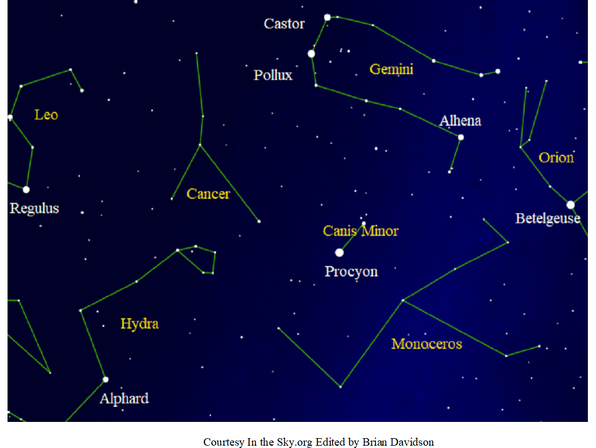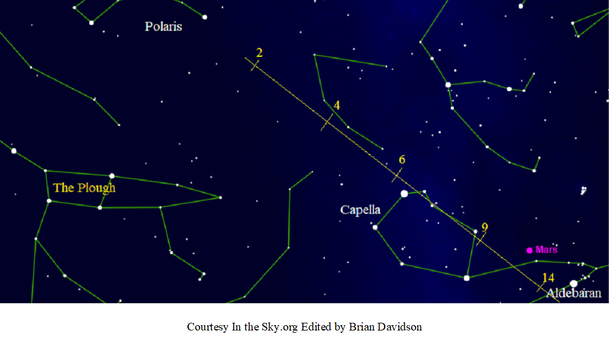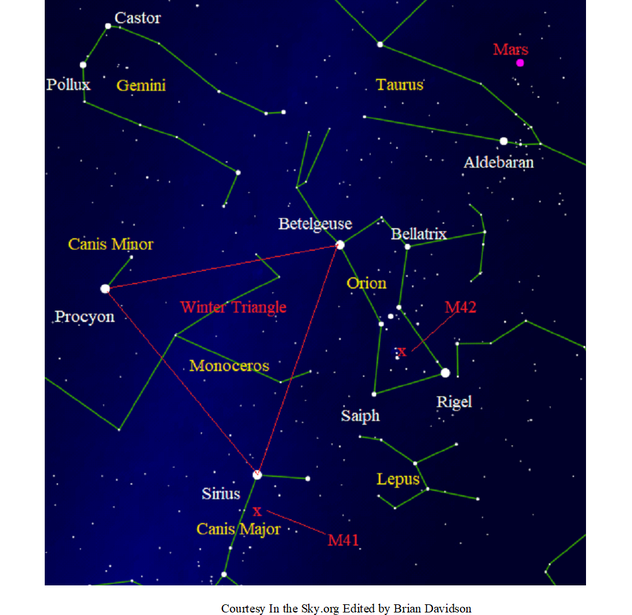|
I think the rule for all star gazers on a clear night during January was make sure that you are well wrapped up and have a warm drink close at hand! Observing The following chart represents the night sky at 10.00pm GMT on the 8th of February and at 9.00pm GMT on the 23rd February. To use the chart, face south at the appropriate time with the bottom of the chart towards the horizon and you will see the stars in the chart. If you are observing earlier in the evening just turn eastwards by 15 degrees for every hour before the stated time but objects will be lower in the sky. Betelgeuse in Orion enables you to locate the area depicted by the chart and in contrast to the ‘big’ sights we’ve been able to enjoy on a clear night during the past two months we’ll have a look at some less noticeable objects this month. Starting with the zodiacal constellation Gemini- The Twins, above and to the left of Orion, we are probably all familiar with the very obvious bright stars Castor and Pollux which dominate their part of the sky. Pollux is a magnitude 1.1 single yellow star while Castor is a magnitude 1.6 star which can be resolved into two stars with a small telescope and a larger telescope will reveal a faint red companion. But the story doesn’t finish there because each of these stars is itself a double making six stars altogether. You just never know exactly what you are observing when you look to the stars! However there is more to this constellation because the bodies of the twins are represented by two lines of faintish stars with their feet in the Milky Way. You should be able to pick out Alhena at magnitude 1.9, representing the feet of Pollux just over halfway between Pollux and Betelgeuse. Below and to the left of Gemini lies another zodiacal constellation Cancer- The Crab. It is the faintest of the zodiacal constellations but fairly easy to find in a dark part of the sky between the bright stars of Gemini and Leo. Finally below and to the left of Cancer and to the left of the bright star Procyon is the constellation Hydra- The Water Snake. It is the largest constellation in the night sky but its long chain of faint stars makes it hard to trace. Its brightest star Alphard marks its heart while its tail is in the southern hemisphere. Something to look out for Some of you may have seen some of the hype in the Press about the comet C/2022 E3 ZTF and how it will be a naked-eye spectacle to enjoy. Forgive me if I am getting cynical in my old age but I have heard this so many times before and ended up being disappointed apart from the comet Hale-Bopp in the 90s which exceeded expectations. I like to be optimistic so the chart above shows you where to look out for this latest comet. I have just drawn the comet’s path free-hand (yellow line) so it is not accurate but should give a good indication of where to look. I suggest you locate Polaris from the Plough and Capella from the Winter Hexagon then use a pair of binoculars to scan the path between them. The comet will be at its brightest at the start of the month but unfortunately there is a full Moon on the 5th which won’t help with viewing. The numbers on the path indicate where the comet is forecast to be on that date in February so the 6th of February might give a chance of seeing it close to Capella.
On Sunday 5th February there is a close approach of Mars and Aldebaran and then on the 22nd the crescent Moon sits midway between the two brightest planets Jupiter and Venus in the west-southwest after sunset. This is prior to the two planets closing in on each other towards the end of the month for their closest approach on the 1st March. Hopefully they will be visible several evenings in succession so that their relative movement can be seen and provide an impressive display. Clear skies.
0 Comments
Some recent clear skies have given us the chance to see the wonderful winter night sky with Orion dominating the scene and with the planets Mars and Jupiter adding that bit extra. Observing The following chart represents the night sky at 10.00pm GMT on the 8th of January and at 9.00pm GMT on the 23 rd January. To use the chart, face south at the appropriate time with the bottom of the chart towards the horizon and you will see the stars in the chart. If you are observing earlier in the evening just turn eastwards by 15 degrees for every hour before the stated time but objects will be lower in the sky. The constellation Orion- The Hunter, dominates the winter night sky this month so let us look at it in a little more detail. It doesn’t take much imagination to see why it represents a person with the four bright stars Betelgeuse, Bellatrix, Rigel and Saiph ranging in magnitudes from 0.3 to 2.1 and defining the shoulders and feet while the three distinctive central stars are his belt. Then below the belt a group of stars form his sword. This latter area contains a huge star forming region known as the Orion Nebula, M42, shown by a red X on the chart. For those of you with good eyesight and clear skies it is visible to the naked eye. However if you get the chance do try to observe it using a telescope. The constellation Canis Major- Greater Dog, lies below and to the left of Orion and it is readily located due to the presence of the brightest star in the sky, Sirius. It shines at a brilliant magnitude of -1.4 because it is relatively close to our solar system at a distance of 8.6 light years. It is part of a binary system, the primary star being orbited by a white dwarf. The constellation Canis Minor- Little Dog, lies to the left of Orion but is one of the smaller constellations and has little of interest apart from its main star, Procyon, a main sequence star of magnitude 0.4 and also relatively close at a distance of 11.4 light years. The three stars Betelgeuse, Sirius and Procyon form a large triangle known as the Winter Triangle, the red triangle on the chart, which helps with navigation of the night sky. Something to look out for For those of you who have been observing Mars closely, its retrograde motion ends on Thursday 12th and it starts moving east again. You may remember it lay between the horns of Taurus when it started retrograde motion on the 30th October whereas it lies considerably to the west of that now. There are two close approaches with the Moon towards the end of the month. On Thursday 26th there is a close approach with Jupiter, visible after 5.00pm above your southern horizon. Then on Tuesday 31st there is a close approach with Mars, visible after 5.30pm to the southeast and culminating around 8.00pm. Clear skies. |
AuthorWMA members Archives
July 2024
Categories |
Proudly powered by Weebly




 RSS Feed
RSS Feed